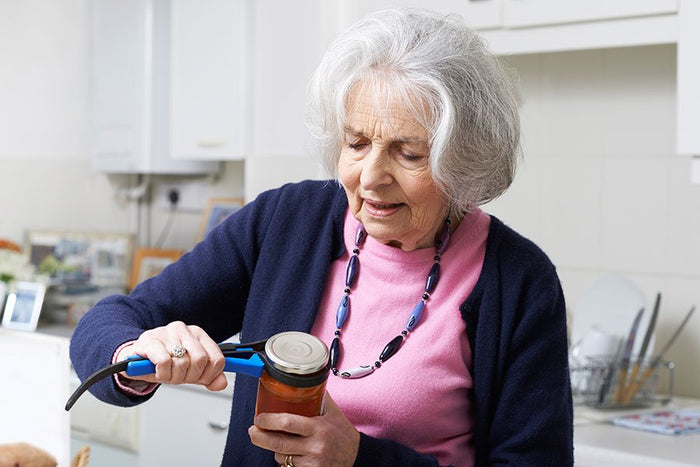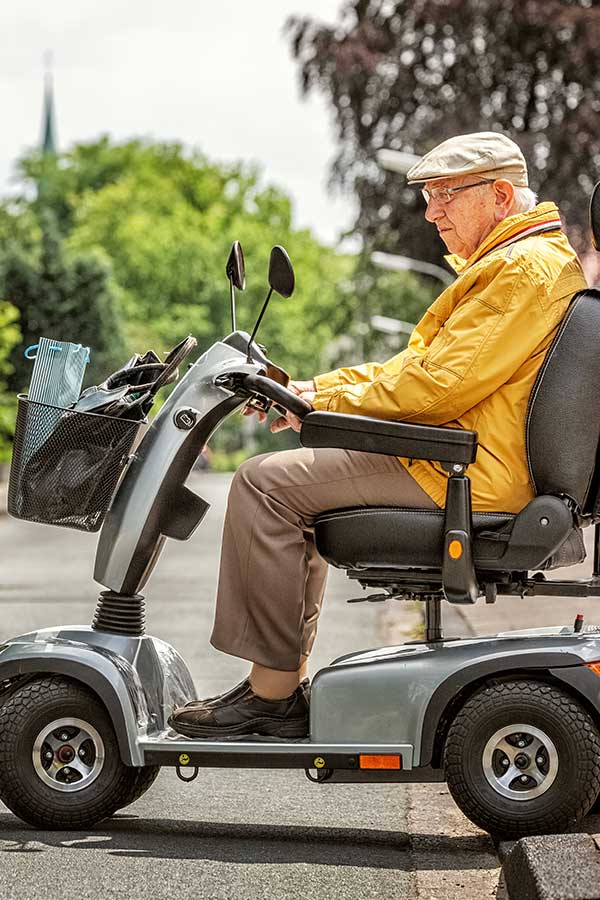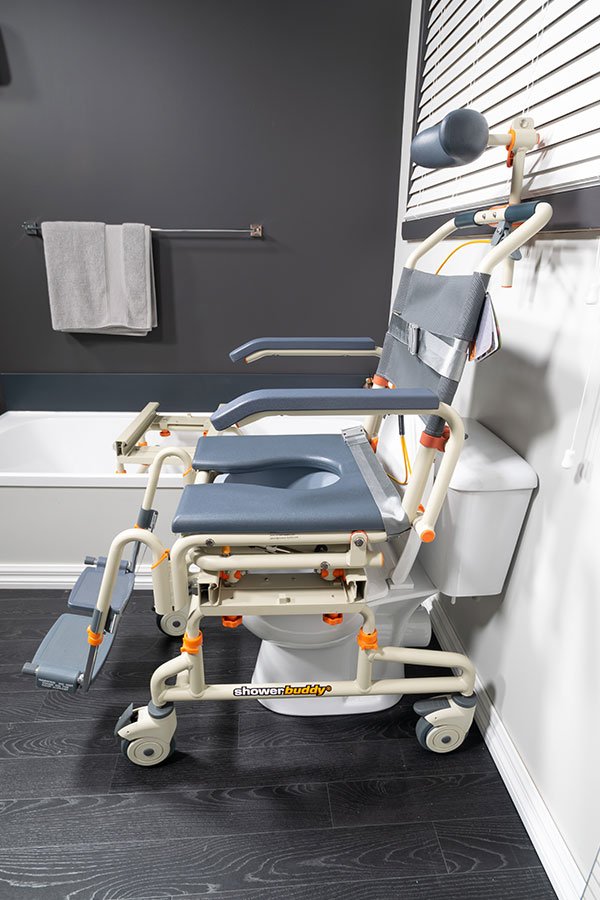-
Ageing and the affect on skills
-
Ageing can affect our movement and motor skills in a variety of ways. It’s typical that our coordination and strength will reduce over time, even if we don’t have a diagnosed condition.
For seniors, a good quality retired lifestyle can be made possible with assistive technology. This refers to equipment that’s designed to assist daily tasks with less physical input required by the user. In this guide we cover some assistive technologies that are useful for elderly people with mobility challenges.
-
Keeping on top of: cooking & eating
-
Kitchen appliances to help elderly cook and eat
Cooking is a favourite pastime of many in our senior community. With more time at home, many get enjoyment from exploring a new recipe or cooking a meal for the family. But there’s a challenge that can hamper this popular hobby; loss of strength or mobility. In an environment where safety is paramount, low mobility presents a real risk to our retired loved ones.
Assistive technology in the kitchen is a popular category and there’s a number of great inventions to help seniors continue cooking and preparing meals even with significant drop in hand strength:
Kitchen assistive: technology
-
![]()
-
Electric can openers and grip tools
Electric can opener devices help elderly people with poor grip strength (and those suffering from arthritis) to open cans safely and without the need for any manual exertion. With canned fruit and veges a popular choice for long term food storage (and thus requiring less trips to the supermarket) within the elderly community, it’s important that the can opening process is made safe and quick!
And for those who get ingredients from a jar such as pickles, tomato paste or jam, a good grip tool is a good investment. These tools may be automatic/mechanical and open the jar completely on their own, or be designed as a manual grip tool that simply reduces the hand strength required to grip and twist the jar open. You may find that the manual version is adequate if mobility impairment isn’t severe.
Vege/fruit choppers
The use of sharp knives with poor hand mobility can result in nasty cuts to one’s hand. The most common foodstuffs that require cutting are usually vegetables and fruit. Instead of continued use of a sharp knife for this preparation, a safe vegetable chopper may be better. These units typically consist of a handle on top of a plastic, contained shell that is placed over whatever you wish to cut. Inside the shell are a number of blades. Often the mechanism for chopping is as simple as pushing down on the unit, with spring loaded blade motion cutting the vegetable swiftly.
Not only are these choppers safer than manually cutting with a knife, they are simple to clean in most cases! You can contain the food in one place, and the unit itself should be dishwasher safe.
Easy pour kettles
Boiling water from the kettle or stove is maybe the most dangerous of kitchen hazards, especially when there’s a heavy quantity of water. A manual kettle that’s boiled by an eldelry user trying to grip and pour it accurately can spell severe burns.
If safety with boiling water is of a concern, look into a kettle that’s designed for easy pouring. Usually these kettles will contain all the typical components of a normal kettle but have an inbuilt stand and pouring mechanism that’s attached to a bracket to keep it steady. The strength to support the weight of the kettle is totally removed, and the accuracy of the pour is mostly taken care of. Each product is slightly different, so make sure you read the instructions and safety disclaimer before making a purchase.
Pot and pan holders
Again, hot water or other liquids is a very common hazard in the kitchen for all of us, but even more so than a mobility imparied senior. A pot or pan holder is a heat resistant bracket that is locked onto the stove and uses a bracket or similar to create a barrier between the side of the pot and anywhere else.
These keep the pots in place, so inadvertent knocks will greatly reduce the chance of a spill and/or burn.
Safety chopping boards
Chopping bread, meat or vegetables on a chopping board might seem straight forward, but when hand strength and manipulation is hampered by age or a condition, this process is actually quite tricky. Consider a chopping board that provides additional food positioning and steadying function, such as a chopping board with high brackets that helps cut loaves of bread and meat evenly and accurately without slippage.
Anti-slip mats and stools
Standing or sitting at the kitchen bench can be made more hazardous when liquids spill on the floor – even a splash from a heavy sink fill can be enough to slip on. You might want to consider rubber mats that offer grip between the floor and your shoes. These anti-slip mats come in all different sizes, so if you or your elderly loved one uses a walker or other assistive technology to get around, you can find a mat that accommodates this too.
Getting: out and about
-
![]()
-
Walking frames for freedom of movement
One of the more familiar assistive technologies to the senior community is that of the walking frame. Walking frames come in many different varieties, with costs ranging from under $100 to beyond $1,000. LIke many product categories, cost is reflective of build quality, features, brand and reliability. A walking frame is central to daily life, so it’s worth getting consultation from a doctor and or occupational therapist over the type of walking frame that’s right for you.
There’s a few considerations you may want to make:
- What size of walking frame suits your body type?
- Can your home and its doorways accommodate this walking frame?
- Do you need a frame with wheels or without?
- Do the grips provide comfort for long periods of time?
- Does the frame have an extended warranty?
- Will the frame be practical to travel with?
Mobility scooters for powered travel
Mobility scooters are electric personal vehicles designed to help elderly people travel short-medium distances. They require no drivers licence to operate and many have the range to transport the user all day from home to the shops and back. They will need daily charging and some low level maintenance such as keeping tyres pumped.
Mobility scooters can be fantastic for the elderly person who desperately wants to have the freedom of personal travel but lacks the mobility or visual acuity to drive a car. Given these are vehicles designed specifically for the elderly, the seats are usually very comfortable with options for extra supports if needed.
A potential drawback is the costs, but you should talk to your local health authorities or OT about potential help with funding. You will also need a practical place to park the mobility scooter at home (they’ll need about the same footprint of space as a ride on a lawn mower), and this place should be easy to drive into and charge (such as a space in the garage).
-
Using tech to: sound the alarm when in need
-
Personal wearable alarms for emergencies
Wearable alarms have become ubiquitous in the 21st century as the growing elderly population strives to maintain independent living but keep safe with an easy communication method. A wearable alarm is placed on the wrist, arm or around the neck as a necklace. It includes a button that sends a signal to either an app, a security company or elderly care provider who can then contact the wearer and their nominated support people that attention is needed. The response to sounding the alarm will vary entirely depending on your specific circumstances. The benefit of these is in the event of a fall or accident, the individual doesn’t need to get to a phone, but simply push the button.
Smart homes and voice assistants
The past 5-10 years have really seen the emergence of voice activated home assistants become commonplace in many homes across the world. And while this assistive technology is certainly not the sole domain of mobility impaired people, it’s been a huge game changer for those in a wheelchair or indeed the senior community who can’t move quickly to access information or adjust things in the home.
A ‘smart home’ is a blanket term for a home that has hardware and software that controls key functions through an app or by voice. For example turning lights on and off, starting air conditioning or closing blinds can all be connected to a smart home system.
Voice assistants such as the offerings from Google, Apple and Amazon can provide seniors with information like the weather, news, recipes or anything else available on the internet. These devices, along with personal mobile phones can be configured to respond to voice commands to call a loved on or carer – another layer of safety and convenience to consider.
-
Furniture that: gives you a lift
-
Elevated bed and lounge furniture
As our muscles lose strength and joints become less manoeuvrable, bending or crouching down to get onto a seat or bed can be tricky to execute. Even harder still, is getting up off a bed or arm chair.
The options for tackling this issue are numerous. First, bed bases that can be raised or lowered are an option, albeit one that comes with a cost. Otherwise a permanently higher bed may be practical and more affordable, where aged users have far less to go to get into and out of the bed.
Armchairs and couches for elderly is a massive industry. These products aren’t just elevated, but offer swivel, leg support, and a high degree of comfort and support. In fact lounge furniture aimed at the elderly market is among the most comfortable chairs available!
Bathroom assistive: devices
-
![]()
Column
-
Elevated toilet seats
Much like sitting down and getting up off a low seat is tricky for a mobility impaired senior, the toilet is a low down fixture that presents a number of challenges.
This is why a popular piece of assistive technology is an add-on for the household toilet that raises the seated position to a height where onboarding and offloading becomes much simpler and less strenuous on the user. These may also come with raised arms alongside the raised toilet seat for additional support.
You’ll want to make sure the elevated or ‘raised’ toilet seat is compatible with your toilet, and that the unit has adequate support for your level of mobility. The seat will need to lock into the existing toilet and have no ‘play’ to avoid instances of slipping off. The issue that one may encounter with this option is that getting off the toilet seat still requires some personal strength and stabilising into a standing position. For those more severely disabled, a transfer system may be better.
Shower chairs and grab bars
Bathing is something everyone should enjoy, but also presents a number of slipping risks and moments of instability. A shower chair is a seat designed for the bathtub or shower that seats the user for support while bathing. These chairs come in a huge variety of configurations. You can learn all about shower chairs in our complete guide here.
Grab bars aren’t a replacement but more an ‘as well as option’ for most elderly with mobility issues. They are textured, installed steel bars that can be grabbed for both movement and stability. While these can be good for users with moderate mobility needs who still have arm strength, they aren’t as useful for those needing more significant help.
The grab bar also needs to be installed securely, which will mean destructive bathroom remodelling; something that can be expensive or even impossible for some homes.
A full bathroom mobility system such as the range we offer allows for toilet use, bathing and complete transfer within the bathroom all from a seated position with no risky movements. If mobility impairment is significant, this is worth a look.
-
More info
-
More information about this topic:
You can find useful information about this topic across the web via the following excellent online resources:
- Assistive Technology – World Health Organisation
- 7 Assistive Technology Devices for Seniors Living at Home – Make Use Of
- Top technology for seniors: Devices and apps to boost wellness, safety and happiness – Care.com
Learn more about Showerbuddy’s range for mobility support
Showerbuddy provides bathroom solutions for mobility-impaired elderly. Head over to our product range page to explore our purpose-built shower chairs.




